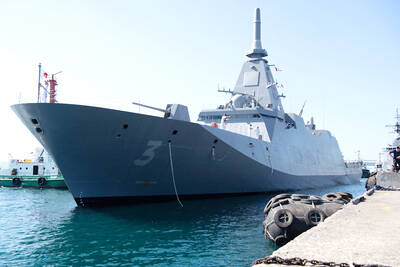Spacewalking astronauts accidentally inserted a pin upside down and jammed an equipment storage platform at the international space station on Saturday, prompting NASA to assemble a special team to try to resolve the problem.
Steven Swanson and Joseph Acaba finished most of their other chores — loosening bolts on batteries, hooking up an antenna and photographing a pair of radiators. But the pin trouble ate up so much time that they had to skip some work.
NASA immediately put together a team of experts to determine whether there’s any way the crew can pry or hammer the pin loose during a spacewalk today, the third and final of shuttle Discovery’s mission.
The lead spacewalk officer in Mission Control, Glenda Laws-Brown, said since there is no up or down in space, Acaba apparently installed the clamp-like pin upside down — “180 degrees out from where it should have been.”
“Even with it being installed in the opposite location, he just drew a card of bad luck ... If it had been rotated just a little bit more or maybe a little bit less, it might have cleared just fine,” she told reporters on Saturday night.
The equipment storage platform ended up being partially deployed on the space station’s framework. To keep it from flapping around, Swanson tied it down with tethers before heading inside.
Those tethers, however, have a certified lifetime of just three months. As a result, engineers were looking at a more permanent solution in case the platform remains jammed.
Saturday’s six-hour excursion was the second in three days for the crew of the Discovery. On Thursday, Swanson and another astronaut installed the final pair of solar wings at the orbiting outpost. The panels were unfurled on Friday.
The latest spacewalk was just as busy, but lacked the drama associated with the multi-million dollar, high-priority solar wings.
NASA was still basking in that success, telling the astronauts in a wake-up message that the space station “now looks like the artist renderings that we’ve been seeing for years. A day to celebrate!”
As soon as they floated outside, Swanson and Acaba, a former Florida schoolteacher on his first spacewalk, made their way all the way to the end of the space station’s power-grid framework. They loosened bolts holding down batteries that will be replaced on the next shuttle visit in June.
A space station alarm went off as the spacewalkers wrapped up that job. The gyroscopes that were maintaining the position of the station-shuttle complex became overloaded from the astronauts’ work on the end of the truss. Discovery quickly assumed control with its thrusters.
“Nothing to worry about,” Mission Control told the astronauts.
The spacewalkers then moved on to the equipment storage platform, where they encountered all the trouble. Mission Control ordered them to give up and move on to installing a Global Positioning System antenna and photographing a pair of radiators, one of which has a peeling cover.
By then, there was no time to set up any equipment shelving on the opposite side of the station. The platforms are meant to hold large spare parts.

Eleven people, including a former minister, were arrested in Serbia on Friday over a train station disaster in which 16 people died. The concrete canopy of the newly renovated station in the northern city of Novi Sad collapsed on Nov. 1, 2024 in a disaster widely blamed on corruption and poor oversight. It sparked a wave of student-led protests and led to the resignation of then-Serbian prime minister Milos Vucevic and the fall of his government. The public prosecutor’s office in Novi Sad opened an investigation into the accident and deaths. In February, the public prosecutor’s office for organized crime opened another probe into

RISING RACISM: A Japanese group called on China to assure safety in the country, while the Chinese embassy in Tokyo urged action against a ‘surge in xenophobia’ A Japanese woman living in China was attacked and injured by a man in a subway station in Suzhou, China, Japanese media said, hours after two Chinese men were seriously injured in violence in Tokyo. The attacks on Thursday raised concern about xenophobic sentiment in China and Japan that have been blamed for assaults in both countries. It was the third attack involving Japanese living in China since last year. In the two previous cases in China, Chinese authorities have insisted they were isolated incidents. Japanese broadcaster NHK did not identify the woman injured in Suzhou by name, but, citing the Japanese

YELLOW SHIRTS: Many protesters were associated with pro-royalist groups that had previously supported the ouster of Paetongtarn’s father, Thaksin, in 2006 Protesters rallied on Saturday in the Thai capital to demand the resignation of court-suspended Thai Prime Minister Paetongtarn Shinawatra and in support of the armed forces following a violent border dispute with Cambodia that killed more than three dozen people and displaced more than 260,000. Gathered at Bangkok’s Victory Monument despite soaring temperatures, many sang patriotic songs and listened to speeches denouncing Paetongtarn and her father, former Thai prime minister Thaksin Shinawatra, and voiced their backing of the country’s army, which has always retained substantial power in the Southeast Asian country. Police said there were about 2,000 protesters by mid-afternoon, although

MOGAMI-CLASS FRIGATES: The deal is a ‘big step toward elevating national security cooperation with Australia, which is our special strategic partner,’ a Japanese official said Australia is to upgrade its navy with 11 Mogami-class frigates built by Japan’s Mitsubishi Heavy Industries, Australian Minister for Defence Richard Marles said yesterday. Billed as Japan’s biggest defense export deal since World War II, Australia is to pay US$6 billion over the next 10 years to acquire the fleet of stealth frigates. Australia is in the midst of a major military restructure, bolstering its navy with long-range firepower in an effort to deter China. It is striving to expand its fleet of major warships from 11 to 26 over the next decade. “This is clearly the biggest defense-industry agreement that has ever